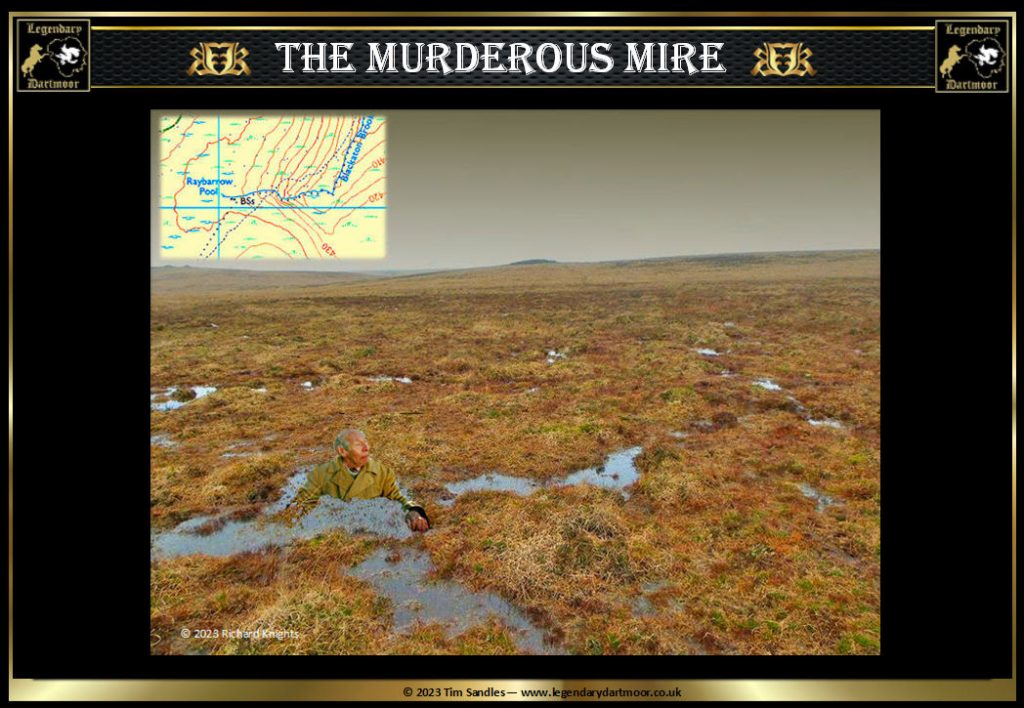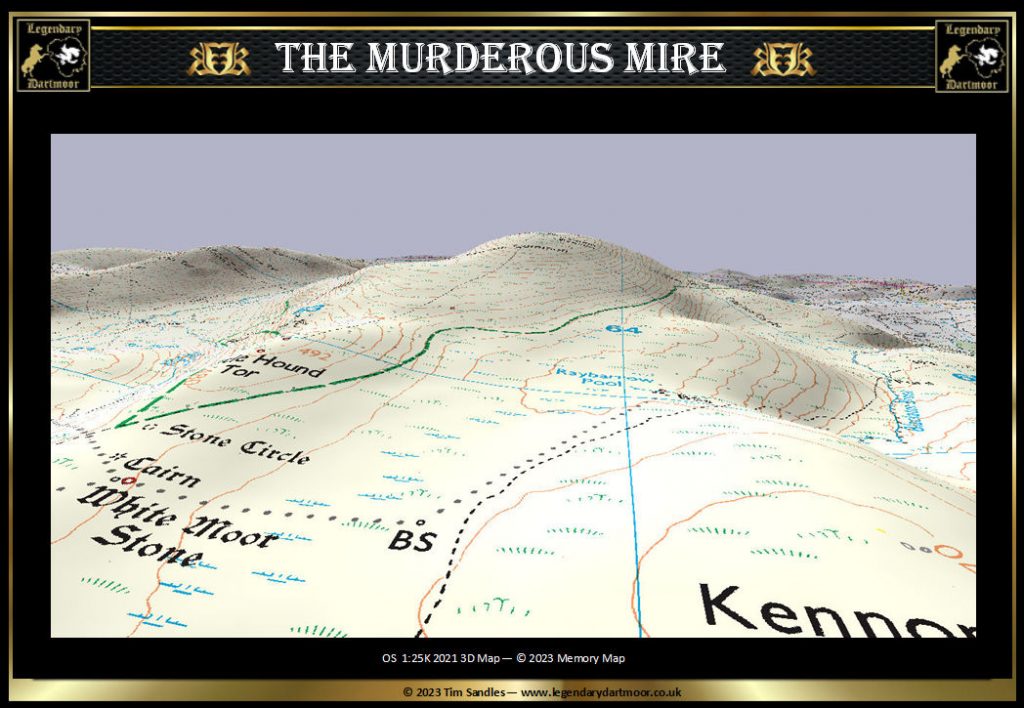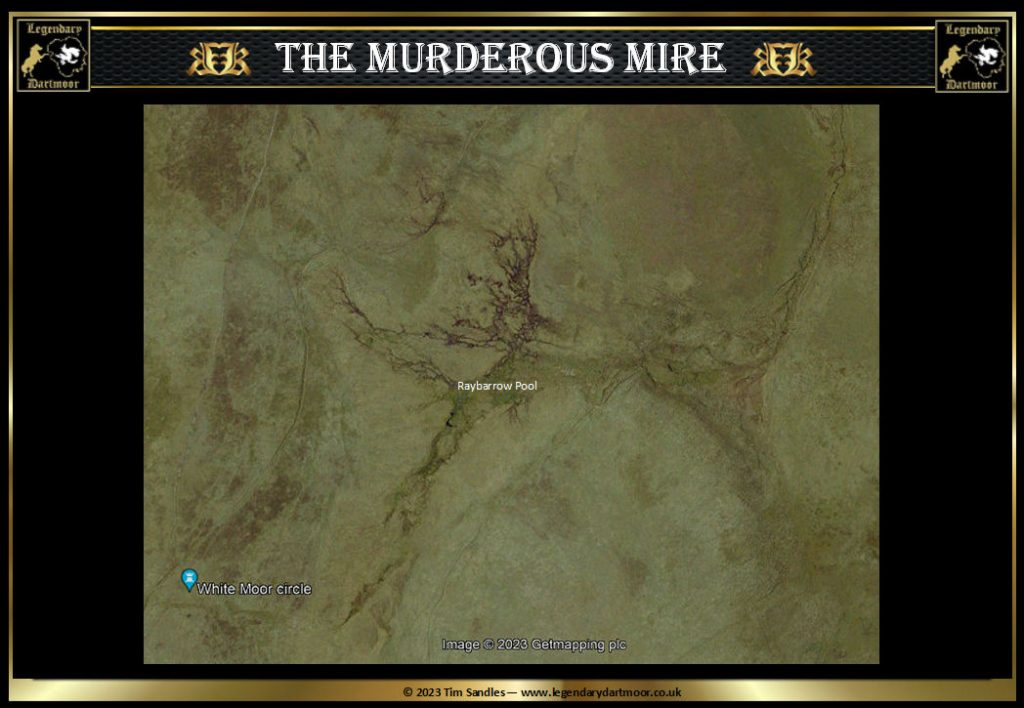
RAYBARROW POOL – described as a Little Tarn, a Mere, a Mire, and more commonly a Pool which probably is the most unlikely descriptive of them all. Just like Cranmere Pool do not expect to see a body of shimmering water or expect a ‘Wild Swim’ (that is available further downstream on the Blackaton Brook). As a landscape feature William Crossing defines them succinctly – ” there are a number of pools, and so-called pools, on the moor, and not one of them, however, being of the slightest importance as such. Certain associations lend some interest to one or two of them, but for the most part they possess little to attract the visitor.” Crossing’s Guide, p.30. He is not far wrong in the case of Raybarrow Pool.
The only plausible explanation as to the etymology of the placename Raybarrow comes from A. B. Prowse. “Raybarrow or Rayborough is less easy to trace; but the following Keltic derivation certainly describes the place well: “Yr ebyr aw” = the meetings (or confluence) of water. The initial vowel being dropped, and the words joined together, the result closely resembles in sound the present name.” – Transactions of the Devonshire Association, 1890, Vol. XXII. p.138. Another slightly weird suggestion being that the name stems from “Ry Bury meaning the ‘Barrow of the Sun’. The puzzling thing is the second name element of ‘barrow’ in normal circumstances on Dartmoor it would suggest either a prehistoric barrow or a corruption of the word ‘burrow’ in association with rabbits, neither of which there is any evidence of.
Raybarrow Pool features in Eden Phillpott’s ‘The Beacon’ and part of the story is when Elizabeth was taunting Reynold Dunning at the pool – “She amused herself with a few little tests. A belated tuft of bog heather made a pearly pink jewel at the edge of Raybarrow Pool. It was separated from the firm ground by a tract of bog, but Lizzie affected not to see this. Even such a blossom had she bade Charles gather for her on a bygone Sunday, and without a remonstrance he had done so, and fouled himself to the knee. ” Could you get me that bit of heather, Mr. Dunning?” she asked, pointing to it.” Don’t you see the bog between?” he asked. ” Never mind if ’twill wet you.” He looked at the heath and then regarded the waste all round it. “Can’t be done,” he said curtly.” If you’d used your eyes half a minute you’d see it couldn’t.”” – 1911, p.83. Obviously Phillpotts was aware if not experienced of the Pool’s reputation.
Call it what you want but in my opinion it is the most heinous and treacherous bog on Dartmoor, yes, even worse than Fox Tor Mires or Aune Head. I first became introduced to Raybarrow Pool on a walk to the Whitmoor Stone. At first glance it looked pretty innocuous, an odd squelch here, another there. But after a few steps more the sight of my boots slowly sinking into the black morass said it was time to turn around. Frustratingly, although my goal was just ahead it meant a long detour around the slopes of Hound Tor – not impressed! Scanning through various books it soon became clear that my opinion is shared by many others, some to their anguish. As can be seen from the OS 3D map below the pool sits in a kind of amphitheatre between Cosdon and Kennon Hills and is an ideal collecting bowl for the run off waters of Cosdon.
William Crossing wrote – “The so-called pool is really an extensive mire, one of the worst in the moorland region, and lies between the foot of the southern slope of Cosdon and that part of Throwleigh common known as Kennon Hill. It is considerably over ½ m. in length from N. to S., but not quite ¼ m. in breadth, except in one place. It is very probable that this swampy flat once merited it name, and that it has been artificially drained by deepening the channel of the Blackaton Brook, which flows from it in the east. No stream runs into the mire, but it receives the drainage of a large area of moorland, and in the rainy season a little water gathers in one part of it.” – Crossing’s Guide to Dartmoor, p.216.
Arthur Wilde’s aired his views on Raybarrow by saying – “We descended Cawsand on the other side, and had our tea overlooking Raybarrow Pool, a small stretch of water which, with its reflection of vivid blue sky, was like a blue lagoon in the sunlight. Raybarrow Pool is the centre of a large bog which is one of the most treacherous on Dartmoor, and I can assure readers that we had to make a very wide detour, during which we had many adventures before we gained dry land at the foot of Kennon Hill.” – The Western Times, April 28th, 1944.
Mike Brown is in no doubt about the mire “I would not even contemplate attempting to cross the Pool, which must surely be the most treacherous area on the whole of Dartmoor. Just a cursory glance at this uninviting swamp, its lush flat sparking green surface resembling that of an enormous quaker, at once reveals its true nature, having none of the clumps of grasses and reed beds which allows one to cross Fox Tor and other mires with caution.” – Dartmoor Field Guides, Vol. 35, p.14.
John Bainbridge recounted this encounter with Raybarrow Pool – “In many years of Dartmoor walking I’ve only ever once nearly come a cropper and that was entirely my own fault. Back in the 1970s, backpacking on north Dartmoor, I was coming down off the hills with a mighty packframe on my back. Feeling lazy, I decided to cut a corner – across Raybarrow Pool, a valley mire of some reputation. It was a silly thing to do, particularly as there had been a lot of rain. I sank down almost to my shoulders, and the pack on my back made it difficult to extricate myself. Eventually I did, emerging Grendel-like from the swamp and having to douse myself in the Teign before returning to civilisation.” – Walking the Old Ways – Dartmoor Bogs, April 23rd, 2019, online source.
On the 2nd of July 1933 Lieutenant-Commander J. C. Clouston left South Zeal with the intent of walking to Postbridge. That same night he had not returned to South Zeal and so the police were notified of his absence. He was still missing on the following day, so an extensive search was initiated which included an aeroplane and a whole host of people. Anyone travelling south from South Zeal would have passed by Raybarrow Pool. As Mr. Clouston had no experience of Dartmoor and its bogs it was decided to concentrate the search around that area. After an exhaustive search there was no indication that he had been there. There had been some live firing around the area two days previously which increased concern for his safety. It was later discovered that Clouston had arrived safely at Postbridge and decided to stay the night at Warne’s Hotel, totally oblivious of the search operation. The sad note to this story is that Lieutenant-Commander J. C. Clouston was killed during the Dunkirk operations on June 2nd 1940.
In 2012 a team of four girls had embarked on the annual Ten tors Challenge and all four managed to sink waist deep in Raybarrow Pool. Luckily, another team found them and summoned assistance. A helicopter flew to the scene and took them all to Okehampton hospital.
On the 29th of September 2020 the police notified the North Dartmoor Rescue Team that a mother and her son had become stuck in Raybarrow Pool. Four team members ventured out to the pool to assess the situation. When they arrived both people had managed to extract themselves from the bog despite having sunk waist deep. They were escorted back to safety.
It was into Raybarrow Pool that Samson Bow lured a notorious gang of sheep rustlers to their deaths.
There is a local tradition that at one time there was a ‘Whispering Stone’ near Raybarrow Pool which if asked at the time of the full moon would reveal who the questioner was to marry. It was also said that at dawn on New Year’s Day the apparition of a beautiful woman could be seen near to the Whispering Stone.
It is said that Water Badgers can be found in the vicinity of Raybarrow Pool. These creatures are a hybrid cross between the common badger and a beaver. They are timid creatures which live on the newts, heather, and other small creatures. If you don’t believe this then simply Google ‘Water Badgers’ for proof.
Having said the pool is a sanctuary for water badgers not every denizen of Dartmoor was safe there. Many fox hound packs, including the South Devon, the Eggesford, frequently hunted the area. Judging by the various reports a fox was nearly always put up from within the mire. Here is a typical report from one of the hunts in 1929 – “Shilstone Combe was called upon unsuccessfully, and then the hounds drew over the moor to Raybarrow Pool, which almost invariably has a fox in residence. Today there were a brace of old stagers here, and hounds, having put them on their pads, unfortunately divided.”
Finally, the fame of Raybarrow spread into the racing world between 1916 and 1922 as Sir S. Watts owned a steeplechaser called “Raybarrow.” The horse had a successful career and raced at many of the well-know racetracks around the country.
 Legendary Dartmoor The many aspects past and present of Dartmoor
Legendary Dartmoor The many aspects past and present of Dartmoor



